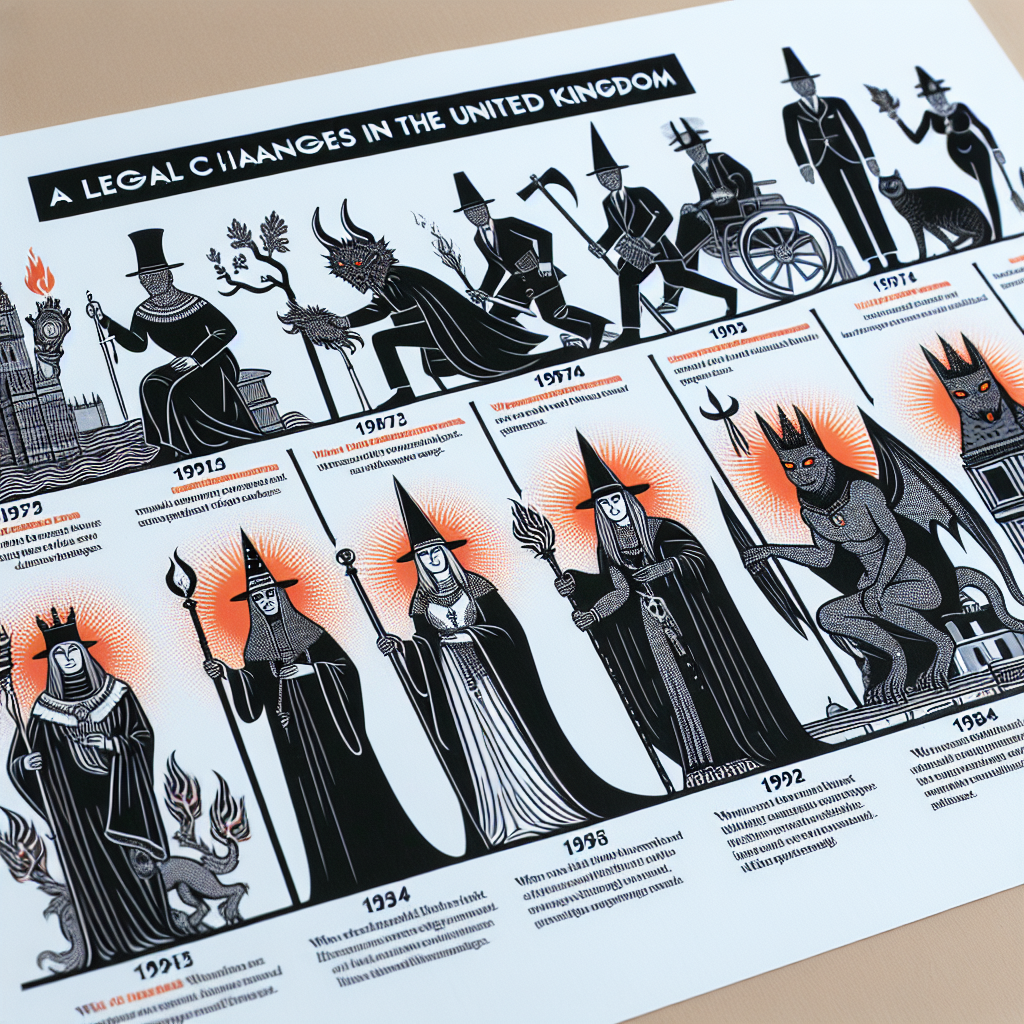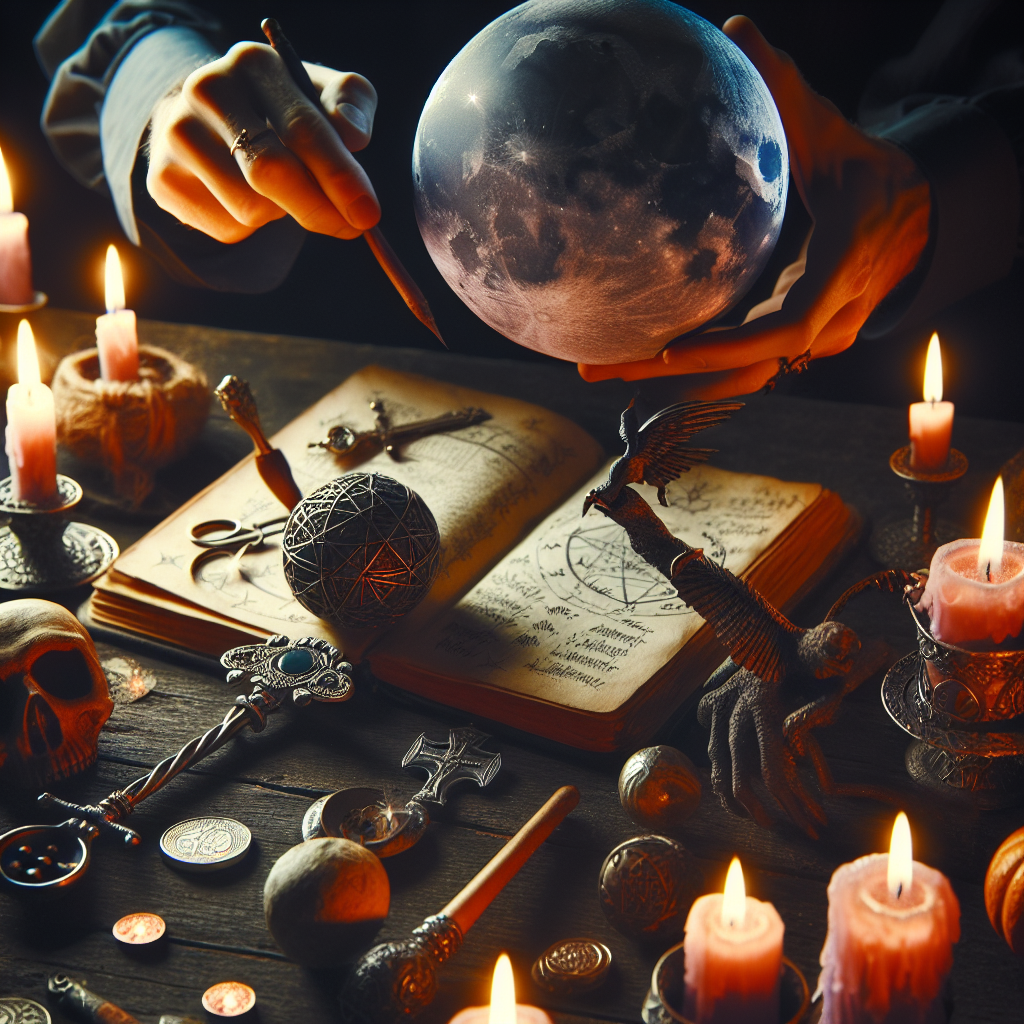As an Amazon Associate I earn from qualifying purchases.
Witchcraft, once a term that conjured intense fear and superstition in the hearts of Europeans, refers to the practice of magical skills and abilities historically believed to be possessed by individuals known as witches. Its legal history in the United Kingdom is both fascinating and tumultuous, revealing much about evolving societal attitudes towards what was once considered a grave threat.
The infamous Witchcraft Act of 1542 was the first to make witchcraft a felony in England, a law promulgated under the reign of Henry VIII. Subsequent Acts in 1563 and 1604 strengthened the legal penalties against witchcraft, reflecting the growing fear and hysteria surrounding the belief in witchcraft's malignant powers. Punishments were severe during this period, with many accused witches being sentenced to death by hanging or burning.
During the Enlightenment, the fever-pitch of witch hunts began to wane, and skepticism about the existence of witchcraft grew. A pivotal moment arrived in 1736 when the Witchcraft Act was repealed and replaced with the Witchcraft Act of 1735. This Act marked a significant shift in legal attitudes. Rather than punishing the practice of witchcraft itself, it targeted people who claimed to possess magical powers, labeling such claims as fraudulent and imposing fines or imprisonment. Essentially, this law sought to extinguish belief in the supernatural power of witches rather than prosecute the supposed practice of it.
Jumping forward to 20th century Britain, the last recorded conviction under the Witchcraft Act of 1735 occurred in 1944, demonstrating the longevity of these outdated legal frameworks. However, in the mid-20th century, renewed interest in the occult and pagan religions catalyzed a push for further legal reform. This reform came with the repeal of the Witchcraft Act in 1951 and the consequent passage of the Fraudulent Mediums Act, which again pivoted the focus from witchcraft to the prevention of fraud by those claiming supernatural abilities for personal gain.
Today, the prohibition of witchcraft is a relic of the past in the United Kingdom, reflective of an era dominated by superstition. Modern society treats witchcraft either as part of historical heritage or as an aspect of contemporary religious practice, notably within certain strains of paganism such as Wicca. Witchcraft has not only become legal; it is now appreciated as a part of the country's diverse tapestry of beliefs. Indeed, figures from the 2011 UK Census suggest that there were roughly 56,620 pagans in England and Wales, illustrating how perceptions and tolerance of different belief systems have evolved. This change signposts a broader societal acceptance of spiritual and religious freedoms that once seemed inconceivable.
“`html
Exploring the Legalization of Witchcraft in the UK: A Historical Overview
“`
The repeal of witchcraft laws in the United Kingdom in 1951 marked a significant shift in legal and societal attitudes towards practices considered as witchcraft. This change was achieved with the passing of the Fraudulent Mediums Act 1951, which replaced the Witchcraft Act of 1735. The 1951 Act no longer treated witchcraft as a criminal offense but instead focused on prosecuting individuals who attempted to deceive others through fraudulent spiritual or supernatural claims for personal gain. This reformation reflected a move away from superstition-based law to a more rational legal framework aligned with contemporary beliefs and values. Transitioning into the broader context, the journey to the legalization of witchcraft is a compelling narrative that charts evolving perspectives on freedom of belief, cultural practices, and the legal mechanisms used to navigate complex social issues in the UK.
Witchcraft ceased to be a legal offense in the United Kingdom with the repeal of the Witchcraft Act 1735, through the enactment of the Fraudulent Mediums Act of 1951. The Witchcraft Act of 1735 marked a significant shift from previous laws as it did not acknowledge the reality of witchcraft as a supernatural phenomenon, but rather focused on prohibiting the claim of magical powers as fraudulent and the practice of witchcraft as a form of deception. The transition reflected a change in societal and legal attitudes, emphasizing rationalism over superstitious beliefs.
This shift was particularly noteworthy against the backdrop of the earlier Witchcraft Acts, such as the Act of 1563 under Elizabeth I which had made witchcraft a capital felony, a stance that was only somewhat softened by the Witchcraft Act of 1604 under James I, which expanded the scope of punishable offenses to include conjuration and enchantments. Executions for witchcraft persisted through these laws, reaching a peak during periods of social and political turmoil.
Throughout the centuries, the legal approach to witchcraft in the UK was largely influenced by prevalent religious and cultural beliefs, with the Christian church playing a significant role in driving the witch hunts and trials. However, by the 18th century, the Enlightenment began to erode the hold of such superstitions, paving the way for a law that no longer punished witchcraft as heresy or regarded it as a diabolical pact but instead treated it as a scam.
Following the repeal of the Witchcraft Act in 1951, the law was replaced by the Fraudulent Mediums Act, designed to prosecute individuals who claimed to possess psychic abilities with the intent of deceiving and profiting from the public. This law remained in force until April 6, 2008, when it was superseded by the Consumer Protection from Unfair Trading Regulations, a broader legislation aimed at protecting consumers from unfair commercial practices, rather than it being an act specifically against witchcraft or spiritual services.
The last witchcraft case in England involved Helen Duncan in 1944, who was imprisoned under the Witchcraft Act of 1735 for falsely claiming to conjure spirits. The case emphasized the Act's use as a tool against fraud rather than a belief in the effectiveness of witchcraft itself.
Though witchcraft is no longer recognized by the law in the UK as a crime, the subject remains of cultural and historical importance. The repeal of anti-wizardry statutes represents a broad societal evolution towards secularism and legal rationalism. Contemporary attitudes towards witchcraft and neo-pagan practices, such as Wicca, reflect a tolerance for diverse spiritual beliefs.
A testament to the dramatic shift in attitudes towards witchcraft is the contemporary prevalence of Wicca and other pagan beliefs in the UK. According to the 2011 Census, there were 56,620 people in England and Wales who identified as Pagan, with a subset of 11,766 specifically describing their religion as Wicca, highlighting the extent to which beliefs once prosecuted are now freely embraced.
“`html
Q1: What was the legal status of witchcraft in the UK before it became legal?
A1: Prior to becoming legal, witchcraft was considered a criminal offense in the UK. It was punishable by various means depending on the period, from fines and imprisonment to execution.
Q2: When was the Witchcraft Act passed in the UK?
A2: The Witchcraft Act was first passed in 1542 during the reign of Henry VIII, and there were subsequent Acts with varying provisions in the years that followed.
Q3: Why were laws against witchcraft repealed?
A3: Laws against witchcraft were gradually repealed as the belief in the supernatural powers of witches declined and the legal system evolved to reflect a more rational and scientific worldview.
Q4: When was the Witchcraft Act 1735 passed, and what did it signify?
A4: The Witchcraft Act 1735 was passed to put an end to the persecution of individuals for witchcraft, signaling the shift from treating witchcraft as a criminal act to a matter of fraud or deception.
Q5: When did the UK fully decriminalize witchcraft?
A5: Witchcraft was fully decriminalized in the UK with the repeal of the Witchcraft Act 1735 by the Fraudulent Mediums Act 1951, which came into effect on April 24, 1951.
Q6: Are there still any laws in the UK that regulate witchcraft or the occult?
A6: While witchcraft itself is no longer illegal, laws such as the Fraudulent Mediums Act 1951, which was replaced by the Consumer Protection from Unfair Trading Regulations 2008, regulate the conduct of individuals who claim to possess supernatural powers for commercial purposes.
Q7: What was the last trial for witchcraft in the UK?
A7: The last trial for witchcraft in the UK before the repeal of the witchcraft laws was in 1944, when Helen Duncan was tried and imprisoned under the Witchcraft Act 1735.
Q8: How did public perception of witchcraft change over time in the UK?
A8: Public perception of witchcraft in the UK evolved from fear and superstition to skepticism and disbelief, which helped pave the way for decriminalization and the acceptance of witchcraft as a cultural or spiritual practice.
Q9: How has the legalization of witchcraft affected modern practitioners in the UK?
A9: The legalization of witchcraft has allowed modern practitioners in the UK to freely practice their beliefs without fear of legal prosecution, leading to a revival and public expression of pagan and witchcraft-related religions.
Q10: Can people in the UK practice witchcraft freely without any legal repercussions?
A10: Yes, people in the UK can practice witchcraft freely as a part of their cultural or religious beliefs without legal repercussions, as long as they do not partake in activities that contravene other laws, for example, fraud or endangerment to others.
“`

Conclusion
Witchcraft in the UK experienced a legal evolution that spans centuries, evolving from a crime punishable by death to eventual decriminalization. Key points in this legal history start with the Witchcraft Act of 1542, the first law passed by Parliament to define witchcraft as a crime. Subsequent legislation, such as the Witchcraft Act of 1563 under Elizabeth I and the 1604 Act under James I, progressively intensified the penalties. The apex of witchcraft persecution came with the 1645 to 1647 witch-hunt led by Matthew Hopkins. However, the legal stance took a significant turn with the Witchcraft Act of 1735, which replaced the capital penalties with fines and imprisonment, redirecting the crime from heresy to fraud. This marked a gradual shift towards skepticism and reduced the legal persecution of alleged witchcraft.
It wasn't until 1951 that the Witchcraft Act of 1735 was repealed through the Fraudulent Mediums Act. This act acknowledged the changing attitudes towards spiritualism and the supernatural, moving away from outright criminalization to preventing fraud. The legal status related to witchcraft in the UK today allows for freedom of belief and practice under the broader protections for religious beliefs, with the focus firmly on preventing exploitation of individuals rather than on witchcraft itself. In essence, witchcraft as a concept became legal when the law ceased to punish the practice and instead aimed to protect individuals from deception, reflecting a significant shift in legal and societal attitudes towards tolerance and rationality.
Amazon and the Amazon logo are trademarks of Amazon.com, Inc, or its affiliates.


